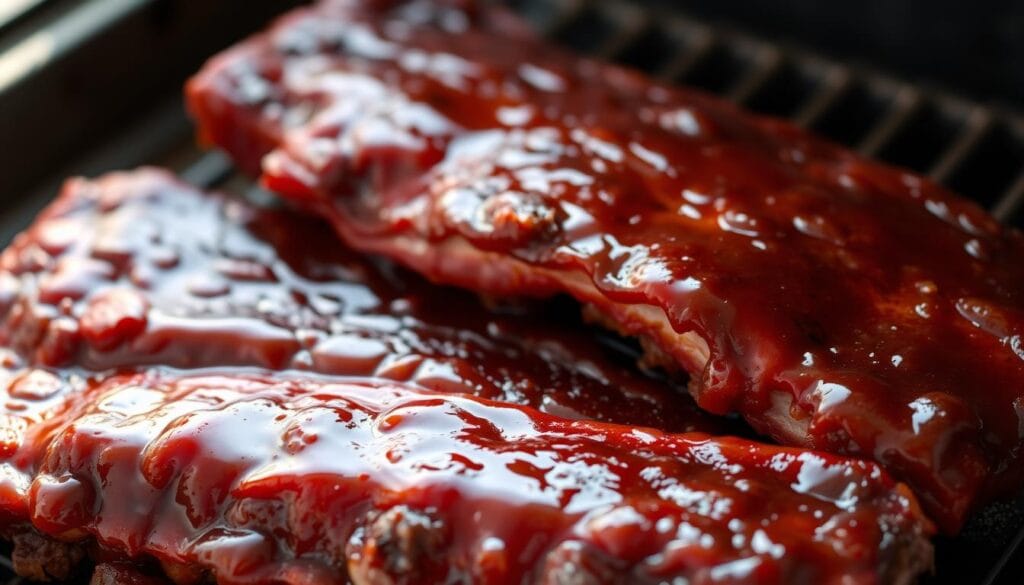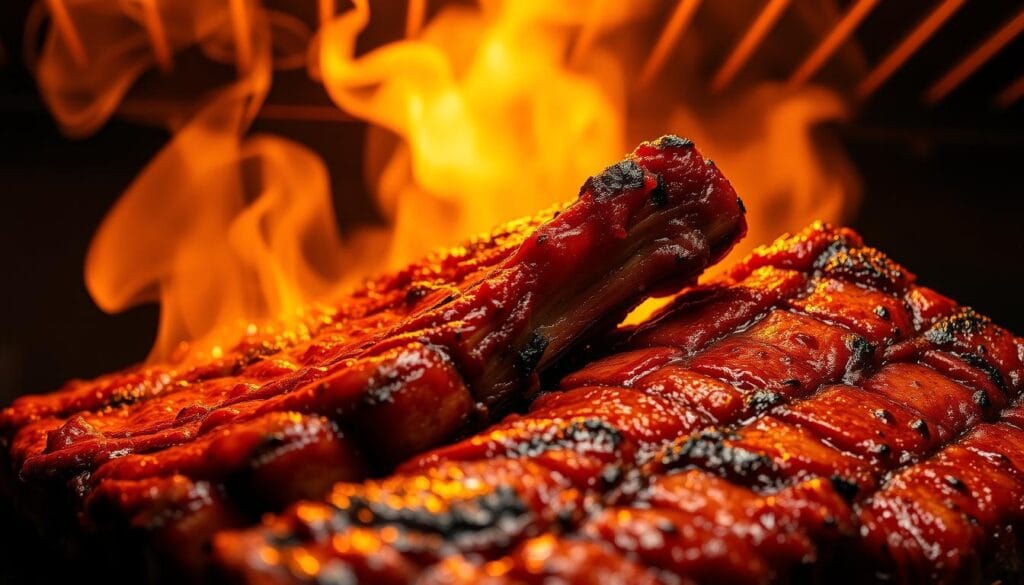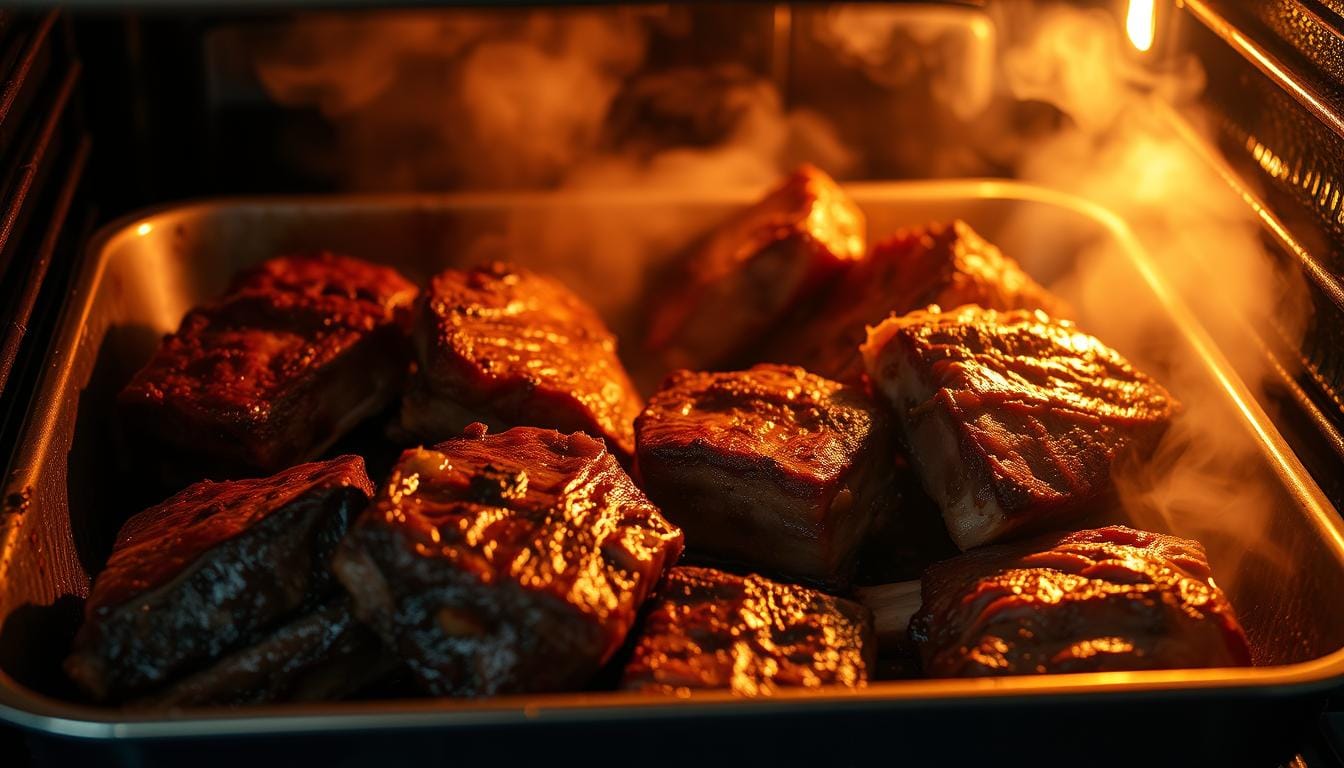How to Cook Beef Ribs in Oven for Perfect Tenderness
The smell of perfectly cooked beef ribs can turn a simple dinner into a special occasion. As someone who has spent many weekends learning to cook beef ribs in the oven, I know the magic of mastering this skill.
Cooking beef ribs in the oven is more than just a method—it’s a journey of patience and precision. Whether you’re an experienced chef or just starting out, learning to cook beef ribs is all about finding the right balance of temperature, time, and technique.
This guide will show you everything you need to know to make delicious beef ribs in your home oven. You’ll learn how to pick the best cuts and achieve that tender, fall-off-the-bone texture. You’ll also discover how to improve your cooking skills and impress your loved ones with amazing beef ribs.
Preparing beef ribs in the oven might seem scary, but with the right steps, it’s actually quite easy. Get ready to learn the secrets of turning tough meat into a juicy, flavorful dish that everyone will love.
Table of Contents
Understanding Different Types of Beef Ribs
When you’re cooking oven roasted beef ribs, knowing the different cuts is key. Beef ribs vary in type, each with its own flavor and cooking needs.
Back Ribs vs Short Ribs: A Detailed Comparison
Beef ribs are mainly divided into back ribs and short ribs. Back ribs come from the upper rib cage, with meat between the bones. They are leaner and known for their tenderness.
- Back ribs contain meat between bones
- Short ribs have meat on top of the bones
- Back ribs are generally less meaty
Choosing the Best Cut for Oven Cooking
For oven cooking, different cuts have their perks. Short ribs offer more meat and flavor, perfect for slow cooking.
| Rib Type | Characteristics | Best Cooking Method |
|---|---|---|
| Plate Short Ribs | Largest, most meaty | Slow roasting |
| Chuck Short Ribs | Rich marbling | Braising |
| English-Cut Short Ribs | Parallel bone cut | Oven braising |
| Back Ribs | Tender, less meat | Low and slow cooking |
Quality Indicators When Buying Ribs
Look for these quality signs in beef ribs:
- Rich, deep red color
- Consistent marbling
- Firm texture
- Fresh appearance
- Minimal excess fat
Pro tip: For the best beef ribs recipe, choose cuts with good marbling to ensure maximum flavor and tenderness.
Knowing these differences helps you pick the right cut for your oven roasted beef ribs. This ensures a delicious and satisfying meal.
Essential Equipment for Oven-Baked Ribs
Cooking beef ribs in the oven needs specific tools for a perfect dish. The right equipment boosts flavor and tenderness.
- Large Baking Dish or Roasting Pan: A sturdy, deep pan for the ribs
- Heavy-Duty Aluminum Foil: For wrapping and sealing in moisture
- Meat Thermometer: To check the internal temperature
- Basting Brush: For applying marinades and sauces
- Sharp Knife: For trimming excess fat and removing membranes
“The right tools can transform your rib-cooking experience from good to exceptional.”
Here’s a detailed breakdown of essential equipment for cooking beef ribs in the oven:
| Equipment | Purpose | Recommended Type |
|---|---|---|
| Roasting Pan | Holds ribs during cooking | Heavy-gauge metal with raised edges |
| Meat Thermometer | Check internal temperature | Digital instant-read probe |
| Aluminum Foil | Seal in moisture | Heavy-duty, wide roll |
| Basting Brush | Apply marinades | Silicone or natural bristle |
Pro tip: If you don’t have a specific tool, don’t worry. Many kitchen items can be substituted. A large sheet pan can replace a roasting pan, and a regular kitchen thermometer works just as well for checking doneness when cooking beef ribs in the oven.
Preparing Your Beef Ribs for Cooking
Creating delicious beef ribs starts with proper preparation. The right techniques can transform your meat from ordinary to extraordinary. This ensures you’ll serve juicy beef ribs that impress everyone at the table.
Removing the Membrane
The membrane, or silver skin, can prevent your seasonings from penetrating the meat. To remove it:
- Flip the ribs bone-side up
- Locate the thin, white membrane covering the bones
- Use a knife to lift a corner of the membrane
- Grip the membrane with a paper towel and pull steadily
“Removing the membrane helps your seasonings penetrate deeper and creates more tender meat.”
Trimming Excess Fat
While some fat adds flavor, too much can make your delicious beef ribs greasy. Focus on trimming thick external fat layers. Leave a thin layer for moisture and taste.
Pat Drying Technique
Before seasoning your juicy beef ribs, pat them completely dry with paper towels. This crucial step helps:
- Improve spice adhesion
- Enhance browning
- Create a perfect exterior crust
By following these preparation steps, you’ll set the foundation for mouthwatering beef ribs. These will have everyone asking for seconds.
The Perfect Seasoning Blend
Creating the right seasoning blend can make your beef ribs truly special. A well-made dry rub locks in flavor and adds a delicious crust. This turns your meat into something as tasty as what you’d find in a restaurant.
“The secret to flavorful beef ribs lies in the perfect balance of spices” – BBQ Experts
Your seasoning blend should have several key ingredients. These work together to bring out the best in beef ribs:
- 1 tablespoon garlic powder
- 1 tablespoon onion powder
- 2 tablespoons dark brown sugar
- 1 teaspoon paprika
- 1 teaspoon chili powder
- 1 teaspoon salt
- 2 teaspoons oregano
Each ingredient is important for depth and complexity. Brown sugar adds a touch of sweetness. Spices like paprika and chili powder add a gentle heat that complements the beef’s rich flavor.
| Ingredient | Flavor Profile | Purpose |
|---|---|---|
| Garlic Powder | Savory | Enhances meat’s natural taste |
| Brown Sugar | Sweet | Creates caramelization |
| Paprika | Mild Heat | Adds color and warmth |
For an extra kick, add 1 tablespoon of cajun seasoning. Mix all dry ingredients well before rubbing them onto your beef ribs. Let the seasoned ribs rest in the fridge for 1-2 hours. This allows the flavors to soak in deeply.
Beef Ribs in Oven: Step-by-Step Guide
Cooking beef ribs in the oven needs care and patience. This guide will show you how to make delicious, tender beef ribs. They will wow your family and friends.
Optimal Temperature Settings
Temperature is key when cooking beef ribs in the oven. Set your oven to 275°F (135°C) for the best results. This low and slow method makes the meat tender without drying it out.
- Preheat oven to 275°F
- Use a reliable oven thermometer for accuracy
- Maintain consistent temperature throughout cooking
Cooking Duration Guidelines
Cooking time for beef ribs depends on their size and thickness. Usually, cook ribs for about 3½ hours for tender meat.
| Rib Type | Cooking Time | Internal Temperature |
|---|---|---|
| Beef Back Ribs | 3-3½ hours | 190-203°F |
| Beef Short Ribs | 4-5 hours | 195-205°F |
Basting Techniques
Keeping beef ribs moist is crucial for great taste. Baste your ribs every hour with beef broth and BBQ sauce. Add about ⅓ cup of liquid to the baking tray to keep it moist.
“The secret to perfect beef ribs is patience and moisture” – Professional Pitmaster
Pro tip for cooking beef ribs in the oven: Use heavy-duty aluminum foil to create a tight seal. This traps moisture and makes the ribs extra tender.
Creating the Ultimate BBQ Sauce Glaze
To turn delicious beef ribs into a mouthwatering masterpiece, you need the perfect BBQ sauce glaze. Your homemade sauce can take flavorful beef ribs from good to extraordinary. It will make your dining experience memorable and impress your family and friends.

Making an exceptional BBQ glaze is all about balancing sweet, tangy, and savory flavors. Here’s a classic recipe to make your signature sauce:
- 1/2 cup brown sugar
- 1/4 cup honey
- 1/3 cup apple cider vinegar
- 2 tablespoons paprika
- 1 teaspoon garlic powder
- 1 teaspoon chili powder
“The secret to exceptional BBQ sauce is finding the perfect balance of flavors.” – Butcher BBQ World Champion
When applying your glaze to delicious beef ribs, timing is key. Professional pitmasters suggest brushing the sauce during the last 30-45 minutes of cooking. This method ensures maximum flavor absorption and prevents burning.
| Glaze Application Stage | Timing | Purpose |
|---|---|---|
| First Layer | 10 minutes | Initial flavor infusion |
| Second Layer | 10-12 minutes | Caramelization and depth |
Want to try something different? Here are some flavor variations:
- Honey Mustard Glaze: Add whole grain mustard for tang
- Smoky Chipotle: Incorporate chipotle peppers for heat
- Fruit-Infused: Mix in raspberry or peach preserves
Pro tip: Always keep your glaze on medium heat and stir consistently. This will help you achieve the perfect thickness. With practice, you’ll make a BBQ sauce that turns your flavorful beef ribs into a culinary sensation.
Monitoring Internal Temperature
To get perfect beef ribs, you need to watch the temperature closely. Knowing how to check the internal temperature makes a big difference. Your meat thermometer is key to making those delicious, tender beef ribs everyone loves.
Optimal Temperature Ranges for Tender Ribs
The best temperature for beef ribs is between 190°F and 210°F. This range ensures the meat is tender and falls off the bone. Several things affect your cooking temperature:
- Low and slow cooking method
- Consistent heat distribution
- Precise internal temperature tracking
Mastering Meat Thermometer Techniques
Here’s how to use a meat thermometer for perfect beef ribs:
- Insert the thermometer into the thickest part of the meat
- Avoid touching bones for accurate reading
- Wait for stable temperature display
“Temperature is the secret weapon in transforming good ribs into extraordinary ribs.”
| Rib Type | Target Temperature | Cooking Time |
|---|---|---|
| Beef Back Ribs | 205°F | 6-8 hours |
| Beef Short Ribs | 200-210°F | 5-6 hours |
Pro tip: Remember that carryover cooking continues after removing ribs from heat, so pull them slightly before reaching final target temperature.
Achieving Fall-Off-The-Bone Tenderness
Mastering oven roasted beef ribs takes patience and skill. The secret to the best beef ribs is knowing how to make tough meat tender and delicious.
To get fall-off-the-bone tenderness, focus on three key things:
- Low and slow cooking method
- Proper moisture retention
- Strategic temperature control
The secret to tender ribs is breaking down connective tissues. Cooking at a consistent low temperature of 275°F to 300°F allows collagen to slowly transform into gelatin, making the ribs tender.
“Patience is the most important ingredient in creating perfect beef ribs.”
Try to reach an internal temperature of 190°F to 200°F. This ensures the meat is tender and flavorful. Using aluminum foil is key – it keeps moisture in and softens the meat.
Here are some tips for your oven roasted beef ribs:
- Cover ribs tightly with foil during initial cooking
- Baste periodically to prevent drying
- Use a meat thermometer to monitor internal temperature
Remember, the best beef ribs recipe takes time. Cook your ribs for about 3½ hours to get that perfect tenderness. This will impress any barbecue lover.
Broiling and Caramelization Techniques
Reaching the top of cooking beef ribs in the oven is the broiling stage. This step turns your ribs from good to amazing. It adds a delicious caramelized layer and crispy edges.

Broiling uses high heat to change the ribs’ outside. It makes a tasty glaze and a crunchy texture. But, you must watch closely to avoid burning and get the caramelization right.
Final Glazing Process
To make a great glaze for your beef ribs, follow these steps:
- Brush ribs well with BBQ sauce
- Put oven rack 4-6 inches from broiler
- Set broiler to high heat
Creating Crispy Edges
To get crispy edges, you need to be precise and quick. Broil your ribs for 4-5 minutes, watching them closely to avoid burning. You want a caramelized outside that keeps the flavor in.
“The secret to perfect ribs is patience and attention during the final caramelization stage.”
Broiling times can differ, but usually, 10-12 minutes total is best. Watch your ribs closely and turn the pan for even caramelization.
| Broiling Stage | Duration | Temperature |
|---|---|---|
| Initial Caramelization | 5-7 minutes | High broil |
| Final Cooking | 5 minutes | High broil |
Pro tip: Cooking in two batches helps with caramelization and prevents steaming. This method ensures each batch of ribs gets a perfect crispy finish when cooking beef ribs in the oven.
Resting and Serving Tips
Resting your flavorful beef ribs is key to a great meal. After cooking for hours, letting them rest makes them even more tender and flavorful.
Resting helps spread out the juices evenly. After taking the ribs out of the oven, cover them with foil. Let them sit for 15 minutes. This step keeps the juices inside when you cut into the meat.
“Patience is the secret ingredient to perfectly tender ribs.” – BBQ Experts
Serving Recommendations
- Let ribs rest at room temperature
- Cover with foil to retain warmth
- Slice against the grain for maximum tenderness
- Serve with complementary side dishes
Ideal Serving Techniques
| Serving Aspect | Recommendation |
|---|---|
| Portion Size | 1-3 ribs per person |
| Resting Time | 15 minutes |
| Cutting Method | Slice between bones |
For a great look, put your juicy beef ribs on a warm platter. Add more BBQ sauce if you like, and top with fresh herbs like parsley or chives. This adds color and freshness.
Remember, patience and detail are key to serving amazing beef ribs. Your guests will love the effort you put into making each bite tender, flavorful, and unforgettable.
Storage and Reheating Methods
Keeping your beef ribs tasty means you need to store and reheat them right. This way, you can enjoy your ribs for days after cooking.
Refrigeration Guidelines
Here’s how to store your ribs to keep them fresh:
- Use airtight containers or heavy-duty aluminum foil
- Refrigerate within two hours of cooking
- Keep ribs in the refrigerator for up to 3-4 days
Freezing Techniques
For longer storage, follow these steps:
- Wrap ribs tightly in freezer-safe packaging
- Remove as much air as possible to prevent freezer burn
- Freeze for up to 4 months
Reheating Methods
Here’s how to make your ribs tender again:
- Oven Method:
- Preheat oven to 250°F
- Cover ribs with foil to prevent drying
- Heat for 20-25 minutes
- Grill Reheating:
- Set grill to medium heat
- Turn ribs frequently
- Reheat for approximately 10 minutes
“The secret to great leftover ribs is gentle reheating and protecting moisture.” – Professional Pitmaster
By using these tips, your beef ribs will stay tender and tasty. You can enjoy them whenever you want.
Conclusion
Cooking beef ribs in the oven is an art that makes any meal special. By using the methods in this guide, you can make ribs that everyone will love. The secret is in the slow cooking at 300°F.
Getting great at beef ribs takes time, patience, and a bit of creativity. Every rack of ribs is different, so feel free to tweak cooking times and seasonings. Aim for an internal temperature of 195°F to 205°F for the best tenderness.
As you get better, you’ll learn to cook ribs without just following a recipe. These oven-baked ribs are perfect for any meal or barbecue. Enjoy the journey and the tasty results of your hard work.
Oven-roasted beef ribs offer endless flavor and versatility. Mastering these techniques opens up a world of possibilities in your kitchen. Bon appétit!
FAQ
How long does it take to cook beef ribs in the oven?
Do I need to remove the membrane from beef ribs?
What’s the best way to season beef ribs?
How do I know when beef ribs are fully cooked?
Can I cook beef ribs without a BBQ sauce?
What’s the best way to store leftover beef ribs?
What sides go well with beef ribs?
Can I cook beef ribs from frozen?
Did You Try Our Recipe?
There are no reviews yet. Be the first one to write one.

